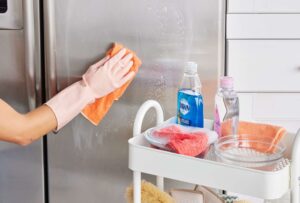
Stainless steel appliances are known for their durability, and they’re a sleek addition to a modern kitchen. But despite the name, stainless steel can stain, and the worst offenders are greasy fingerprints and hard water spots.
The best way to keep your stainless steel appliances clean is to wipe them down regularly so that grease, gunk, and water spots don’t have a chance to build up.
While we will use our environmentally responsible products on your stainless steel appliances during your regular cleans, there are household ingredients you can use for a touch-up in between! Here’s how to clean stainless steel appliances from the refrigerator to the dishwasher to keep your kitchen shining.
The Best Cleaner for Stainless Steel Appliances
Harsh cleaners like bleach and some commercial all-purpose cleaners can eventually wear through stainless steel’s protective layer and lead to corrosion. Similarly, abrasive cleaners like steel wool soap pads can scratch the finish.
The best cleaner to use for routine stainless steel cleaning is a mixture of mild dish soap and warm water. Since stainless steel is easy to scratch, avoid abrasive cleaning cloths, and reach for a soft microfiber cloth instead.
How to Clean Stainless Steel Appliances
Stainless steel is easy to clean but if it gets too dirty, it’s easy to overdo it, leaving you with unsightly scratches and smudges. Regular upkeep to remove fingerprints and grime can keep it looking like new. Here’s the best way to get fingerprints and grime off your stainless steel appliances without risking damage:
1. Gather your supplies. You’ll need three soft microfiber cloths — one for cleaning, one for rinsing, and one for buffing.
2. Mix your cleaning solution. Add a few drops of your favorite mild dish soap to a bucket or bowl of warm water.
3. Wipe with the grain. Dip your microfiber cloth in the soapy water and wring out the excess. Wipe the appliance surface in the direction of the grain. Cleaning with the grain increases shine and prevents the formation of microscopic crevices in the steel that can fill with dirt and grime.
4. Rinse with clean water. Wet the second microfiber with clean, warm water, and wring out the excess. Go over the stainless steel surface again to remove remaining dirt and soap.
5. Dry and buff immediately. Use the third microfiber cloth to thoroughly dry the surface (always in the direction of the grain) to remove streaks, buff out smudges, and prevent water spots.
Deeper Cleaning for Stubborn Stains
If your stainless steel appliance is particularly gunky or greasy, break out the white vinegar. Its acidic properties help break down grease — but those same properties can damage your stainless steel if you leave it on too long. Here’s how to do it right:
1. Mix equal parts white vinegar and water in a spray bottle.
2. Spray the appliance, and let it sit for a minute or less — but no longer.
3. Wipe it with a microfiber cloth in the direction of the grain.
4. Rinse with a clean microfiber cloth and water.
5. Dry the appliance thoroughly with a clean, dry microfiber cloth.
How to Polish Stainless Steel
Want that extra stainless steel shine? Give it a polish with olive or mineral oil, which adds a protective layer against fingerprints and grime. Pour a dab of oil onto a clean microfiber cloth and buff with the grain until you have a shiny, flawless finish. Wipe away any excess oil with a clean cloth.
Top Issues Cleaning Stainless Steel
Stainless steel is simple to clean. However, common cleaning mistakes can leave it looking smudged or streaky. If your appliances don’t have the shine you’re hoping for, check to see if something in your method could change. Here are a few common issues with cleaning stainless steel and how to solve them.
Mistakes that Leave Streaks on Stainless Steel
If you’re frustrated with ugly streaks on your dishwasher or refrigerator, you’re not alone. Streaks are perhaps the most common issue with cleaning stainless steel because there are several possible reasons for the streaks:
- Wiping against the grain or in a circular motion. Rubbing against the grain can make stainless steel lose its shine or even create tiny divots that allow dirt to collect and expose the material to corrosion.
- Using a dirty cloth. A dirty, greasy rag can smear dirt along the appliance rather than cleaning it.
- Not using enough cleaner to dissolve grease. If grime is only partially broken down, it could slide down the appliance in an unattractive streak. Make sure you use enough cleaner and wash any off thoroughly.
- Not adding moisture back to the appliance. After cleaning, stainless steel is left dry and dull. Add polish to brighten the appliance, serve as a protective layer, and prevent streaks.
Why Are There Water Spots?
If you have hard water, you may notice dingy water stains forming on your freshly cleaned appliances. Water spots on stainless steel often come from calcium in the water. For most stains, you can dampen a clean microfiber cloth, wipe the stain, and follow with a dry microfiber cloth.
Keep Your Kitchen Sparkling Clean
Caring for your stainless steel appliances requires consistency. If you need a hand deep cleaning the kitchen (or any other rooms of the house), give Casillas House Cleaning Service a call at (775) 357-4216 or request a free estimate online today.


